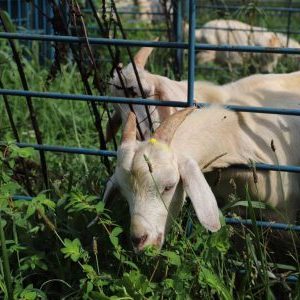About Us

Due to the rise of inquiries about small ruminant production, Alabama Extension at AAMU hosted the Alabama Sheep and Goat Summit on Saturday, September 25, 2021. This event allowed sheep and goat producers the opportunity to address on-farm concerns and challenges. They also had a chance to engage with a wide range of professionals to improve the efficiency of small ruminant production systems. Participants gained knowledge and resources through the collective efforts of Alabama Extension’s animal science and forages team and faculty from AAMU’s Food and Animal Science Department.
Introductions
Participants were greeted with a warm welcome from Alabama Extension employees as they filed by information booths. Each booth disseminated vital information and giveaways to promote Alabama Extension and the Small Ruminant program. The educational sessions began shortly after attendees gathered inside AAMU’s Winfred Thomas Agricultural Research Station (WTARS) auditorium. All participants followed COVID protocols set by the Centers for Disease Control and Prevention.
AAMU Extension administrators greeted and introduced other program participants. Following introductions, an overview of WTARS, including its current projects and purpose was presented. This introduction encouraged community engagement and support of innovative agricultural research projects.
Silvopasture Demonstration
From the meeting room, the group moved to the Western area of WTARS for silvopasture demonstrations. Producers toured the ongoing goat demonstration project where Kiko goats are used to control understory vegetation in forestland areas.
While at the silvopasture demonstration, producers experienced and discussed several topics related to small ruminant production. AAMU faculty member and researcher Loretta Weninegar delivered an excellent overview of plants potentially toxic to goats and sheep. She explained several of the signs and symptoms associated with each plant located at the site. Producers also actively engaged with Weninegar about various plants and experiences they encountered on their farms.
As the group absorbed the information, Valens Niyigena and Kozma Naka shared their expertise and experiences around raising goats in a silvopasture system. This presentation focused on the advantages and disadvantages of incorporating a silvopasture system into goat production. It was emphasized that although goats are a viable way to increase income from existing timber stands, the actual progression depends on the capability of a farmer and their available resources.
Infrastructure Discussion
Before returning to the main meeting room, a discussion was held regarding infrastructure requirements to support minimal operations once established. Participants discussed current farm conditions, such as fence repairs, adding water systems in different paddocks of the farm, and predator control methods.
The lunch break allowed participants to network. Several attendees took the opportunity to gain further clarification about best management practices. Discussions revealed a diverse group of producers. For example, some producers were veteran livestock farmers, while others were in the planning stages. The wide range of producer knowledge was a bonus for the summit. More experienced livestock producers readily shared their insights and lessons learned.
Breakout Sessions
After lunch, youth and adults attended breakout sessions that included discussions and hands-on activities. Adults attended a session on Drugs, Disposal, & Downstream Effects by Will Sander, Karnita Garner, and Allyson Shabel. Following this session, Niyigena and Bobwealth Omontese delivered a presentation on Heat Detection and FAMACHA Scoring.
In collaboration with the Alabama 4-H team, youth engaged in fun and interactive agricultural and animal science-related activities. These activities were provided by James Fountain and William Seldon, urban regional Extension agents. The younger attendees concluded their session with a tour of the WTARS facility that exposed them to various projects around the Food and Animal Science Department. This exposure to agricultural production will hopefully cultivate the next generation of farmers, ranchers, and agricultural educators.

